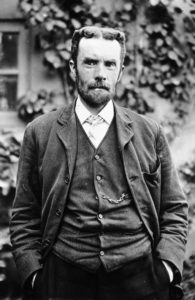Oliver Heaviside
 Linear Systems and Signals, 2nd Edition, B.P. Lathi
Linear Systems and Signals, 2nd Edition, B.P. Lathi
Although Laplace published his transform method to solve differential equations in 1779, the method did not catch on until a century later. It was rediscovered independently in a rather awkward form by an eccentric British engineer, Oliver Heaviside (1850-1925), one of the tragic figures in the history of science and engineering. Despite his prolific contributions to electrical engineering, he was severely criticized during his lifetime and was neglected later to the point that hardly a textbook today mentions his name or credits him with contributions. Nevertheless, his studies had a major impact on many aspects of modern electrical engineering. It was Heaviside who made transatlantic communication possible by inventing cable loading, but no one ever mentions him as a pioneer or an innovator in telephony. It was Heaviside who suggested the use of inductive cable loading, but the credit is given to M. Pupin, who was not even responsible for building the first loading coil. In addition, Heaviside was:
- The first to find a solution to the distortionless transmission line.
- The innovator of lowpass filters.
- The first to write Maxwell’s equations in modern form.
- The codiscoverer of rate energy transfer by an electromagnetic field.
- An early champion of the now-common phasor analysis.
- An important contributor to the development of vector analysis. In fact, he essentially created the subject independently of Gibbs.
- An originator of the use of operational mathematics used to solve linear integro-differential equations, which eventually led to rediscovery of the ignored Laplace transform.
- The first to theorize (along with Kennelly of Harvard) that a conducting layer (the Kennelly-Heaviside layer) of atmosphere exists, which allows radio waves to follow the earth’s curvature instead of traveling off into space in a straight line.
- The first to posit that an electrical charge would increase in mass as its velocity increases, an anticipation of an aspect of Einstein’s special theory of relativity. He also forecast the possibility of superconductivity.
Heaviside was a self-made, self-educated man. Although this formal education ended with elementary school, he eventually became a pragmatically successful mathematical physicist. He began his career as a telegrapher, but increasing deafness forced him to retire at the age of 24. He then devoted himself to the study of electricity. His creative work was disdained by many professional mathematicians because of his lack of formal education and his unorthodox methods.
Heaviside had the misfortune to be criticized both by mathematicians, who faulted him for lack of rigor, and by men of practice, who faulted him for using too much mathematics and thereby confusing students. Many mathematicians, trying to find solutions to the distortionless transmission line, failed because no rigorous tools were available at the time. Heaviside succeeded because he used mathematics not with rigor, but with insight and intuition. Using his much maligned operational method, Heaviside successfully attacked problems that the rigid mathematicians could not solve, problems such as the flow of heat in a body of spatially varying conductivity. Heaviside brilliantly used his method in 1895 to demonstrate a fatal flaw in Lord Kelvin’s determination of the geological age of the earth by secular cooling; he used the same flow of heat theory as for his cable analysis. Yet the mathematicians of the Royal Society remained unmoved and were not the least impressed by the fact that Heaviside had found the answer to problems no one else could solve. Many mathematicians who examined his work dismissed it with contempt, asserting that his methods were either complete nonsense or a rehash of known ideas.
Sir Willian Preece, the chief engineer of the British Post Office, a savage critic of Heaviside, ridiculed Heaviside’s work as too theoretical and, therefore, leading to faulty conclusions. Heaviside’s work on transmission lines and loading was dismissed by the British Post Office and might have remained hidden, had not Lord Kelvin himself publicly expressed admiration for it.
Heaviside’s operational calculus may be formally inaccurate, but in fact in anticipated the operational methods developed in more recent years. Although his method was not fully understood, it provided correct results. When Heaviside was attacked for the vague meaning of his operational calculus, his pragmatic reply was, “Shall I refuse my dinner because I do not fully understand the process of digestion?”
Heaviside lived as a bachelor hermit, often in near-squalid conditions, and died largely unnoticed, in poverty. His life demonstrates the persistent arrogance and snobbishness of the intellectual establishment, which does not respect creativity unless it is presented in the strict language of the establishment.
